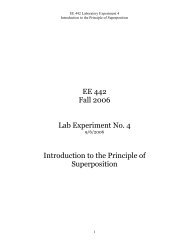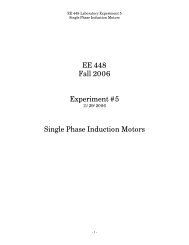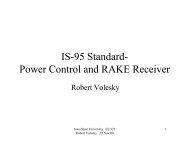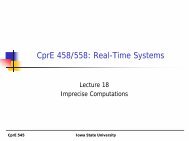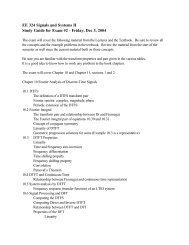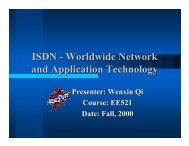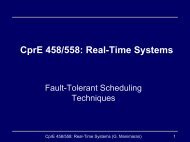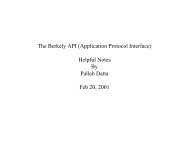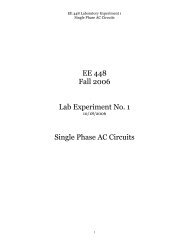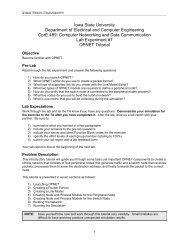Deterministic protocols for real-time communication in multiple ...
Deterministic protocols for real-time communication in multiple ...
Deterministic protocols for real-time communication in multiple ...
You also want an ePaper? Increase the reach of your titles
YUMPU automatically turns print PDFs into web optimized ePapers that Google loves.
132S. Norden et al. / Computer Communications 22 (1999) 128–136Fig. 1. Mapp<strong>in</strong>g of nodes <strong>in</strong>to vertices of CR tree.of slot 4 and 7, respectively. At <strong>time</strong> 9, the node <strong>in</strong> the rightsubtree (N 4 ) will transmit its notifier successfully, and transmitsits message successfully be<strong>for</strong>e the deadl<strong>in</strong>e.For the LDCR protocol, the threshold used <strong>for</strong> defermentis taken to be 1. The behaviour of LDCR protocol is similarto MDCR up to <strong>time</strong> 2, i.e., after transmission of the notifierof message at N 1 . After transmission of the notifier, theLDCR computes the laxity <strong>for</strong> this message and f<strong>in</strong>ds thatthe laxity is greater than threshold, hence defers themessage. At <strong>time</strong> slot 4, N 2 transmits its notifier, and f<strong>in</strong>dsthat the laxity of the message is zero, hence the message istransmitted immediately. The protocol proceeds <strong>in</strong> thismanner.From the above example, it can be noted that the LDCRprotocol transmits all the messages successfully, while theMDCR protocol can transmit only 50% of the messages.The key aspect that contributes to the improved per<strong>for</strong>mance<strong>in</strong> LDCR is the deferment of the message at N 1 ,which has a large laxity. This allows more critical messagesat N 2 , N 3 , etc., to be transmitted be<strong>for</strong>e their deadl<strong>in</strong>es.4. Simulation studiesTo study the effectiveness of the proposed <strong>protocols</strong>, wehave conducted extensive simulation studies. For eachsimulation run, 10000 messages were generated <strong>for</strong> theentire system. For the per<strong>for</strong>mance results, 95% confidence<strong>in</strong>tervals were obta<strong>in</strong>ed. The per<strong>for</strong>mance metrics used, andthe simulation model are def<strong>in</strong>ed below:4.1. Simulation model and parameters• N: Number of nodes on the network.Table 3Simulation parametersParameter Explanation Value when varied (fixed)N Number of nodes 5…30 (10)M Average message length 7…20 (20) slotsa Laxity parameter 2…25 (10)Load l M N 0.1…1 (0.6)P/Nt Packet to Notifier ratio 2…10 (10)• M: Average message length (or service <strong>time</strong>).• a: Laxity parameter which decides the deadl<strong>in</strong>e ofmessages, directly proportional to deadl<strong>in</strong>e. The deadl<strong>in</strong>eis uni<strong>for</strong>mly chosen <strong>in</strong> the <strong>in</strong>terval [C i ,a*C i ].• l: Mean message arrival rate at a node. Message arrivalat each node follows Poisson distribution with mean arrivalrate l.• L: Load on the network is def<strong>in</strong>ed as the product ofnumber of nodes (N), mean message length (M), andthe arrival rate, i.e., L ˆ (l * M * N).• (P/Nt): Packet to notifier ratio. As mentioned earlier, slotis a basic unit of transmission <strong>in</strong> which one packet can betransmitted. We fix a normalized value of packet slot tobe 10 <strong>time</strong> slots, and from this ratio, we can determ<strong>in</strong>ethe number of slots used by transmission of a notifier,relative to this normalized value of a packet slot.The simulation parameters and their ranges are given <strong>in</strong>Table 3.4.2. Per<strong>for</strong>mance metrics• Success Ratio (SR): This is def<strong>in</strong>ed as the ratio of thetotal number of messages transmitted successfully to thetotal number of messages that arrived <strong>in</strong> the system. TheSR is an important metric which reflects the throughputof the network.• Effective Channel Utilization (ECU): This is the ratio ofthe <strong>time</strong> slots used <strong>for</strong> successful transmission to thenumber of <strong>time</strong> slots that elapsed until all messageswere transmitted or dropped. A higher value of ECUwould imply that the channel utilization, as result ofsuccessful message transmission, is large compared tothe net overhead as result of collision and notifier transmission.• Normalized Transmission Length (NTL): This is theratio of the mean length of the transmitted messages tothe mean length of the generated messages. The closer itsvalue to one, the less bias towards longer or shortermessages. In other words, when the NTL offered by aprotocol is one, the protocol behaves <strong>in</strong>dependent ofmessage service <strong>time</strong>.4.3. Results and discussionIn this section, we compare the per<strong>for</strong>mance of theproposed <strong>protocols</strong> (MDCR and LDCR) with a recentlyproposed protocol called PBCSMA. The PBCSMA protocolis chosen <strong>for</strong> comparison because it can support multipacketmessages, and has been reported to per<strong>for</strong>m better than theVTCSMA and CSMA based <strong>protocols</strong> [15]. It is a modifiedversion of p-persistent CSMA with support <strong>for</strong> differentpriority levels of traffic. Note that the MDCR, LDCR, andPBCSMA are best ef<strong>for</strong>t <strong>protocols</strong>, which means that theyadmit all the messages arriv<strong>in</strong>g <strong>in</strong> the system, withoutguarantee<strong>in</strong>g that these messages will be transmitted



